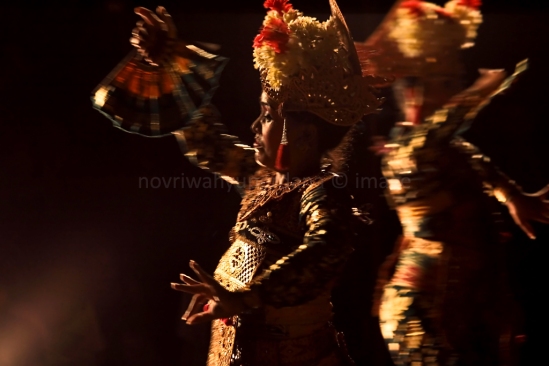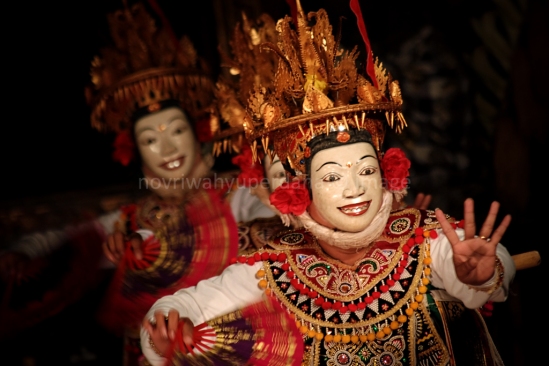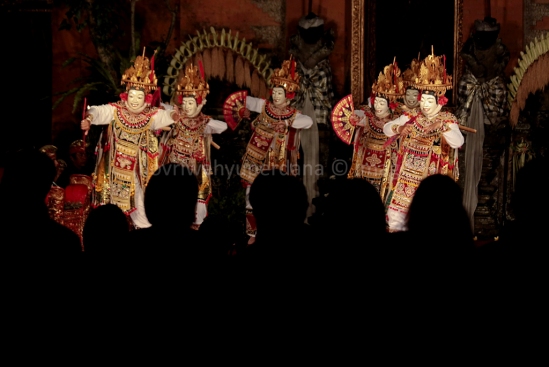Ubud palace – or also known as Puri Saren, a place that was build by the King of Ubud around the 16th century when Bali was ruled by Kings and Princess, is offering all tourist three dances performance that held in a time every Friday at 07.30 pm. The palace itself that deviced into various of yards has been place one of its yards, the Ancaksaji court to be use for art performances.
In the Opening Act, one Legong dancer is entering the dance court while plays her dance following the gamelan music’s rhythm. The unique of this dance is the dancer was always seen widened her eyeballs while glanced to the right and to the left side.
After the opening act, two dancers were seen entering the dance court with holding a propeller in their hands and join the first dancer to dance together. The Legong Kraton Dance is performed by three female dancers in colourfull costums.
Legong is a classical balinese dance group that has so many and very complex motion tied with percussion accompaniment structures said to be the influence of gambuh. The word comes from the word Legong itself, consisting of “Leg” which means a elastic or flexible dance, and “Gong” which means or refers to the gamelan. Legong thus implies a bound dance (especially its accentuation) by the accompanying gamelan. The gamelan that used to accompany the dance called Gamelan Semar Legong Pagulingan.
Legong developed in the royal courts of Bali in the second half of the 19th century. It is said that the idea started from a prince of Sukawati, during his illness saw two girls dancing gracefully accompanied by a beautiful gamelan in his dream. When the prince recovered from his illness, his dream was manifested in the repertoire of dances accompanied with a full gamelan.
In accordance with the onset, the standard legong dancers consist of two girls who have not had a period, danced in the moonlight in the palace yard. Both dancers are called Legong and they always equipped with a propeller as a assisted tools. In some other Legong dance there is a additional dancers, called condong, which not equipped with a propeller.
The dance structures generally consist of papeson, pangawak, pengecet, and pakaad. In times, legong had lost popularity in the early 20th century by the rise of Kebyar form from northern Bali. Revitalization efforts began since the late 1960s, by digging back the old documents for reconstruction.
Legong Kraton Dance once ussually staged in the palace courtyard to entertain the king. The story is adapted from the classical story of King Lasem in which the arrogant King Lasem desired the unwilling Princess Langke Sari whose father he plants to stay. King Lasem himself is alter killed in a battle.
In the 2nd Scene, a Barong was entering the dance court after the Legong dancers went out from the dance court. Barong is a character in the mythology of Bali. He is the king of the spirits, leader of the hosts of good, and enemy of Rangda in the mythological traditions of Bali. Banas Pati Rajah is the fourth “brother” or spirit child that accompanies a child throughout life. Banas Pati Rajah is the spirit which animates Barong. A protector spirit, he is often represented by a lion, and traditional performances of his struggles against Rangda are popular parts of Balinese culture.
The Lion Barong is one of five traditional Barong. In Bali each region of the island has its own protective spirit for its forests and lands. Each Barong for each region is modeled after a different animal. There is a boar, a tiger, a dragon (or serpent) and the traditional lion. The lion is the popular one as it comes from the Gianyar region where Ubud (the home of tourist viewed ritual) is located. Within the calonarong, the dance drama in which the Barong appears, the barong responds to Rangda’s use of magic to control and kill her to restore balance.
Telek dancers were entering the dance court in the 3rd Scene. Telek dance usually performed by four or more dancers wearing white masks of beauties or devils perform the battle between the virtue and the vice. A typical balinese view of the world, “Rua Bineda”, which mean everything has two sides, that is, any world is knitted together with opposing two elements, is said to have been represented in this dance.
Derrived from the epic legend of ancient India, Ramayana and Mahabrata, the story has been accomplished as the present one. Out of many kinds of masked dances in Bali, Jauk and Telek can be categorized as the most singular one. These masked figures which still exist in Bali today. Jauk is the male version of this genre where the dancers putting on the devil mask and its expression is more violent and far exaggerated then that in Baris Dance, while Telek is the female one.
In Jauk, the males wear special conical, pointed chandelier-like head-dress in the shape of a Buddhist stupa. The masks are similar in form and bright red color. The style of carving and painting resembles the mask of Rawana in Wayang Wong. The face is fierce, with large eyes, shiny visible teeth, and moustache and beard. The dancers wear long artificial finger-nails.
In Telek, the corresponding female characters, the dancers refined masks are also uniform, they are white in colour with visible teeth, but the expression is pleasant and smiling. These masks are identical to the Sang Hyang Legong masks preserved in Ketewel. The female dencers also wear the identifying pagoda-shaped crown and carry fans.
Jauk and Telek is closely associated with Barong performance. Jauk usually serves as the attendant of the Barong while Telek serves the Rangda, the opposite of the Barong. In some areas in Bali, Jauk is correspond to Sandar while Telek to Omang. However, as a matter of fact, can be performed as solo dance, it is usually ten to twenty minute solo accompanied by Gong orchestra, no story is connected with the solo performance. Beryl de Zoete and Walter Spies in their book “Dance and Drama in Bali” also mentioned Jauk as a part of Calonarang performance, in which Jauk served as King Jayasenggara while the Telek served as the disciples of Calonarang.
At the present time the Jauk dancers are rarely seen in dance-drama, and the Telek dancers are hardly to be found at all. Two style of solo dance for a male dancer clad as Jauk, however, are commonly included in concerts presenting a sampling of different kinds of Balinese dance.
Sisya were entering the dance court in the 4th Scene. There was written in the story that in the middle of a dark-moon night, a group of girls dance a trange magic rite. These girls are Sisya, the black magic pupils whose pratictices their black spiritual teaching under the guidance of Rangdeng Dirah, a weadow witch from Dirah.
The epic story told that once, there was a kingdom ruled by the king named Sri Aji Airlangga. In the times he ruled, he brought prosperity to his people. There are so many other Kingdom whose wanted to unite under he’s rules in that time. But inside the Kingdom there was one place that called Dirah which lead by the spiritual black magic teacher called Rangdeng Dirah, which means a weadow witch from Dirah, who taught the black magic and wants the destruction of the kingdom. Then, Mpu Bharadah – a white-magic guru whose also a spiritual teacher of the ruling King, bears an order from the King to healed all the victims of Rangdeng Dirah black magic power.
After a long time search, Mpu Bharadah finally found the graveyard where Rangdeng Dirah and her black magic spritual group practiced. Mpu Bharadah politely asked Rangdeng Dirah to stop her evil challenge. But Rangdeng Dirah refused. Instead, she was challenged Mpu Bharadah to prove his magic power. She burned a banyan tree by her black magic power. Rangdeng Dirah also tried to burned Mpu Bharadah’s body with fire that came out from her mouth, but it did not work. She kept trying to do that, but Mpu Bharadah remains strong and still.
Mpu Baradah then immediately do the yoga and then turned back the banyan tree that had been destroyed in flames like it was before. After that Mpu Bharadah turned burning the tree and challenged Rangdeng Dirah to extinguish it. But Rangdeng Diran unable to extinguished the fire. Knowing that she had loss, Rangdeng Dirah then transforms herself become a giant monster known as Rangda.
In order to defeat Rangda, Mpu Bharadah turned himself into Barong, the good monster protector. In the fight againts Rangda, a number of villagers also gave their support to Barong. In this situation, Rangda the drops her white cloth which contains of her black magic power. Men whose helped Barong then felt an evil power entering their bodies. They fight this black magic power and piercing their kerises onto their own bodies. Barong then heals all of those who had been influenced by the Rangda evil power.
And that is the end of the whole dances perfomance. If you have a chance to travel to Bali, you have to visit Ubud and watch this performances. I really had a great moment and opportunity to captured this wonderful perfomances.
___________________________________________________________________________________
Copyright © 2009 Novri Wahyu Perdana. All rights reserved.
All images were taken by using Canon EOS 50D, Canon EF 70-300mm F/4-5.6 IS USM, and Canon EF-S 18-55mm F/3.5-5.6 IS.












We really need copy writers badly. After checking out your site, we want you on our crew. We pay $35 TO $50 per hour. Our prime writers are pulling in over $90K a YEAR, writing part-time.
Please swing by and see us. http://write.ncsall.org